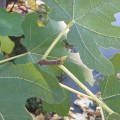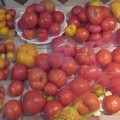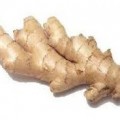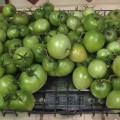Sweet anise tasting herb. Leaves are used in salads and soups, or to flavor sauces (bearnaise) and vinaigrette. Pairs well with seafood and poultry dishes.
Botanical Information
Taxonomy
Artemisia dracunculus var. sativa
History
Physical Description
- grows up to 2′ tall and is slightly bushy – about a foot wide
- The 2″ leaves are long & slender, and grow out along the plants many stems
- It does flower, but they are tiny & pale green. They don’t open or produce seed.
Varieties & Cultivars
Categories or Types of Tarragon
There are a few different plants that are called Tarragon, but only A. dracunculus is the true French Tarragon.
- Russian Tarragon: A. dracunculoides
- larger, coarser, not useful in cooking
- Mexican Tarragon: Tagetes lucida, also known as Sweet Mace
- a member of the marigold family
- perennial in hot climates
- aromatic oils are similar to French Tarragon (anise), can be used as a substitute
- grows taller, and not as delicate as French Tarragon
- yellow flowers, and is rather pretty in a border
Growth Requirements
Climate & Temperature Requirements
Air Temperature
Soil Temperature
likes a good bit of cold (almost freezing) temperatures to go dormant (author suggests two-months, minimum)
Humidity
harder to grow in high humidity
Day Length or Light Requirements
Site Conditions Favored
- Full sun in northern areas, but some shade in sunny, hot regions is good
- needs sunlight to develop good flavor, so too much shade leads to dull flavor
Soil Requirements
Soil Texture
- requires good drainage
pH
Nutrient Requirements
Propagation
Methods of propagation
Seed
Division
- Best bet for propagating
- late winter, or very early spring, lift the oldest patches of plants with a garden fork
- discard roots without any green shoots
- trim roots with shoots attached to fit in a small pot (author suggests 4″ pots)
- use a fast-draining soilless mix
- keep in shade for two weeks to let the root hairs develop
Cuttings
- can be done, but they can be fragile
Transplanting or Potting Up
Seed Saving
Planting Out
Bed Prep & Soil Amendments
Bed Spacing
Row Spacing
Planting Depth
Alternative Bed Methods
Container Gardening
Does well for one season, but once the roots fill it, the flavor goes away
Routine Cultivation & Maintenance
Water Requirements
- young plants: water every other day during dry weather
- mature plants: water ever 3 days to keep leafy
- mature plants can survive long periods without water, but they won’t produce new leaves
- steady watering produces best flavor
Fertilization Recommendations
top-dress with compost every winter
Mulching & Weeding
Pinching or Pruning & Dividing
- cut back (or harvest) half the plant in late June (or late spring), cutting about 6″ off the ground
- should be ready to harvest again in six weeks
Support
Winterizing
Companion Planting
Helpful Companions
Harmful Companions
Companion to..
Pests, Diseases & Problems
Common Pests
Common Diseases
Symptoms
Whole Plant
Leaves
Stem/Trunk
Flowers
Fruit
Roots
Harvesting & Storage
Edible Parts of the Plant
leaves and tender new stems
Yield
Heavy users should grow 3 to 4 plants for continuous supply from early spring to late fall
Days to Harvest / Harvest Timing
late June: harvest half the plant to promote good production throughout the summer
Harvest Methods
Storage of harvest
Fresh
Canned
Frozen
good method to preserve flavor; chop & freeze in water
In Vinegar
gold way to preserve the flavor
Dried
not very effective, since the anise flavor compounds are volatile (gas off quickly)
Cooking
Nutritional Benefits & Values
Toxicity
Cooking
Preparation
Cooking Methods
Recipes
Resources
Information for this article was taken from these sources:







